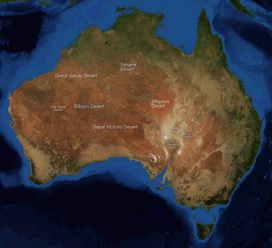
Back Deserts d'Austràlia Catalan بیابانەکانی ئوسترالیا CKB Australische Wüsten German Dezertoj de Aŭstralio Esperanto Desiertos de Australia Spanish صحراهای استرالیا Persian Australian aavikot Finnish Désert australien French Desertos de Australia Galician Gurun di Australia ID
| Great Australian Desert | |
|---|---|
 The Great Australian desert is the 4th largest desert by area after the Antarctic, the Arctic and the Sahara. | |
 Typical landscape (Simpson Desert) | |
| Length | 4,710 km (2,930 mi) |
| Width | 1,890 km (1,170 mi) |
| Area | 2,700,000 km2 (1,000,000 sq mi) |
| Geography | |
| Country | Australia |
| States | List
|
| Coordinates | 24°34′S 137°25′E / 24.57°S 137.42°E |
The deserts of Australia or the Australian deserts cover about 2,700,000 km2 (1,000,000 sq mi), or 18% of the Australian mainland, but about 35% of the Australian continent receives so little rain, it is practically desert.[1] Collectively known as the Great Australian desert, they are primarily distributed throughout the Western Plateau and interior lowlands of the country, covering areas from South West Queensland, Far West region of New South Wales, Sunraysia in Victoria and Spencer Gulf in South Australia to the Barkly Tableland in Northern Territory and the Kimberley region in Western Australia.[2]
By international standards, the Great Australian desert receives relatively high rates of rainfall or around 250 mm (9.84 in) on average, but due to the high evapotranspiration it would be correspondingly arid.[3] No Australian weather stations situated in an arid region record less than 100 mm (3.94 in) of average annual rainfall.[4] The deserts in the interior and south lack any significant summer rains. The desert in western Australia is well explained by the little evaporation of the cold sea current of the West Australian Current, of polar origin, which prevents significant rainfall in the interior of the continent.[3] About 40% of Australia is covered by dunes.[5] Australia is the driest inhabited continent,[6][7] with the least fertile soils.[8][9]
In addition to being mostly uninhabited, the Great Australian Desert is diverse, where it consists of semi-desert grassy or mountainous landscapes, xeric shrubs, salt pans, gibber (stony) deserts, red sand dunes, sandstone mesas, rocky plains, open tree savannahs and bushland with a few rivers and salt lakes, which are mostly seasonally dry and often have no outflow in the east. The 3 million km2 desert is among the least modified in the world.[10] The Australian desert has the largest population of feral camels in the world.[11][12]
- ^ Deserts by Geoscience Australia
- ^ Geosciences Australia –Deserts
- ^ a b Aleshire, Peter; Geoffrey H. Nash (2007). Deserts: The Extreme Earth. Infobase Publishing. p. 137. ISBN 978-1438106663. Retrieved 27 September 2015.
- ^ Mabbutt, J. A. (2012). "Landforms of the Australian Desert". In El-Baz, F. (ed.). Deserts and arid lands: Volume 1 of Remote Sensing of Earth Resources and Environment. Springer Science & Business Media. p. 78. ISBN 978-9400960800. Retrieved 27 September 2015.
- ^ Cite error: The named reference
dadwas invoked but never defined (see the help page). - ^ "The Australian continent". Bureau of Meteorology. Retrieved 13 August 2018.
- ^ "Deserts". Geoscience Australia. Australian Government. 15 May 2014. Retrieved 13 August 2018.
- ^ Kelly, Karina (13 September 1995). "A Chat with Tim Flannery on Population Control". Australian Broadcasting Corporation. Archived from the original on 13 January 2010. Retrieved 23 April 2010. "Well, Australia has by far the world's least fertile soils".
- ^ Grant, Cameron (August 2007). "Damaged Dirt" (PDF). The Advertiser. Archived from the original (PDF) on 6 July 2011. Retrieved 23 April 2010.
Australia has the oldest, most highly weathered soils on the planet.
- ^ Venter, Oscar; Sanderson, Eric W.; Magrach, Ainhoa; Allan, James R.; Beher, Jutta; Jones, Kendall R.; Possingham, Hugh P.; Laurance, William F.; Wood, Peter (23 August 2016). "Sixteen years of change in the global terrestrial human footprint and implications for biodiversity conservation". Nature Communications. 7: 12558. Bibcode:2016NatCo...712558V. doi:10.1038/ncomms12558. ISSN 2041-1723. PMC 4996975. PMID 27552116.
- ^ Managing the impacts of feral camels in Australia: a new way of doing business. Desert Knowledge CRC Report Number 47. Accessed 8 May 2014.
- ^ Northern Territory > Department of Land Resource Management > Feral Camel Archived 8 May 2014 at the Wayback Machine. Accessed 8 May 2014.
© MMXXIII Rich X Search. We shall prevail. All rights reserved. Rich X Search